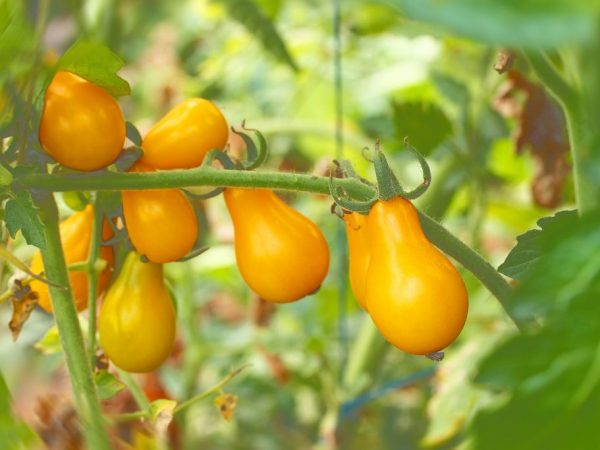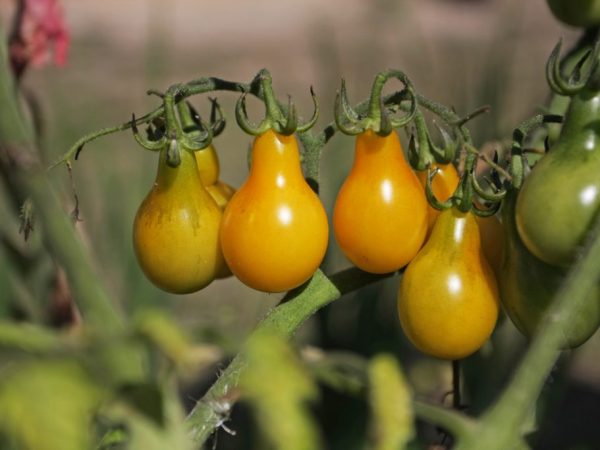Characteristics of tomato honey drop
Liana-shaped tomatoes with bright fruits most often attract the attention of farmers and ordinary gardeners. They are used not only for decorating a vegetable garden or garden. These are ideal products to be used to decorate your holiday table. The yellow tomato honey drop belongs to the liana-like category.

Characteristics of tomato honey drop
Characteristics of the variety
This variety was bred by Russian breeders of the Gavrish company. It was originally created to be grown in a greenhouse, but the constant improvement of the variety now allows the species to be grown in open areas. In 2003, the Honey Drop tomatoes were entered into the State Register of the Russian Federation.
The characteristic suggests that this variety can only be grown in warm climates. That is, only in areas where summer lasts for a long time. In areas where a temperate or cool climate prevails, it is better to grow in a greenhouse, because in cool weather all the ovaries will not be able to ripen in time.
Description of the plant
The plant matures in an average amount of time. The growing season is about 100 days from the day the first signs of seedlings appear. The bush is of an indeterminate type, that is, its growth is not limited. The bush does not belong to the standard category. Its height can reach several meters. For this reason, tying and props are required.
The foliage is quite large, a bit like potato foliage. Small roughness is formed on the surface. It is imperative to form a bush of 2-3 stems in order to improve productivity.
Description of the fetus
The description and characteristics of the variety indicate that the fruits are small in size. Their color is presented in rich yellow shades, which fits perfectly into the whole green concept of the garden plot. The weight of the fruit does not exceed the mark of 20 g. The peel is dense and smooth in structure.
According to the characteristics, the pulp of tomatoes is juicy, but does not have a watery structure. The tomatoes taste a little sweet, with a little sourness. The species is universal, since it can be consumed fresh and is excellently suited for preservation for the winter.
Benefits
When considering the description and characteristics of the variety, the following positive features can be distinguished:
- seeds germinate with a 95 percent probability;
- unique quality of taste and presentation;
- versatility in use;
- high yield rates: it is possible to collect about 6 kg of selected tomatoes from 1 bush;
- seed material is not translated and can be used for planting next year.
The peculiarity of this species is that it needs regular tying and the presence of supports. He puts forward requirements for proper watering, fertilizing and soil selection.
Growing rules

Compliance with the rules will help you get a good harvest.
Tomatoes Honey drop should be planted at the beginning of March.To begin with, seeds are sown, which have several years of aging. Before planting, they should be treated with a solution of manganese or peroxide. This will destroy any germs and bacteria that have accumulated on the surface.
Prepare the soil before planting. If it is not saturated with useful substances, it is recommended to add them yourself. You can prepare a mixture of humus, peat and sand. After that, the soil is treated with disinfectants. Seeds should be planted in soil warmed to 20 ° C. After planting, all holes must be watered with warm water.
Seedlings are planted in open ground, already containing several petals. This is best done in early June. The distance between the rows should be kept at 40 cm. Between the holes it should be about 50 cm. The planting depth is 2 cm.
Care
If you grow tomatoes in a greenhouse, it is important to change the surface layer of the soil every year, otherwise the plant will simply not be able to form correctly and will soon die. Immediately after planting, the plant is propped up with special wooden boards, because the height of the bush is quite large. Trellis can be used so that the vines can develop normally. The bush must be formed into several stems, after which all side stepchildren are removed.
Watering is carried out only with water at room temperature. To increase yields, watering should be done once a week. Greenhouse rooms must be ventilated daily. Every day it is necessary to loosen the soil and remove all weeds. Top dressing is carried out 2 times a month. Each time, solutions of organic and mineral substances should be alternated. It is best to dilute them with water. As soon as the first ovaries have formed, potassium supplementation should be followed.
Prophylaxis
This species has a good immune system against many diseases. But the problem is that it can become infected from neighboring varieties that do not have such immunity. As a preventive measure, mulching of the inter-row space with peat compounds and straw is used. It is important to spray the plant with special substances that prevent the occurrence of fungal and viral infections.
To protect themselves from parasites, the greenhouse is ventilated every day and the plants are sprayed with special solutions of celandine or peroxide. To get rid of the aphid infestation, it is recommended to use a special soap solution. Each plant is treated with this solution, but the substance is added in a small amount.
Conclusion
F1 honey drop is a unique plant species that is ideal for growing in rural areas. It can be used not only by gardeners for their own purposes, but also by agronomists for sale in large quantities. Many industrial enterprises buy such fruits to prepare baby vegetable food or canning tomatoes to decorate a festive table.


